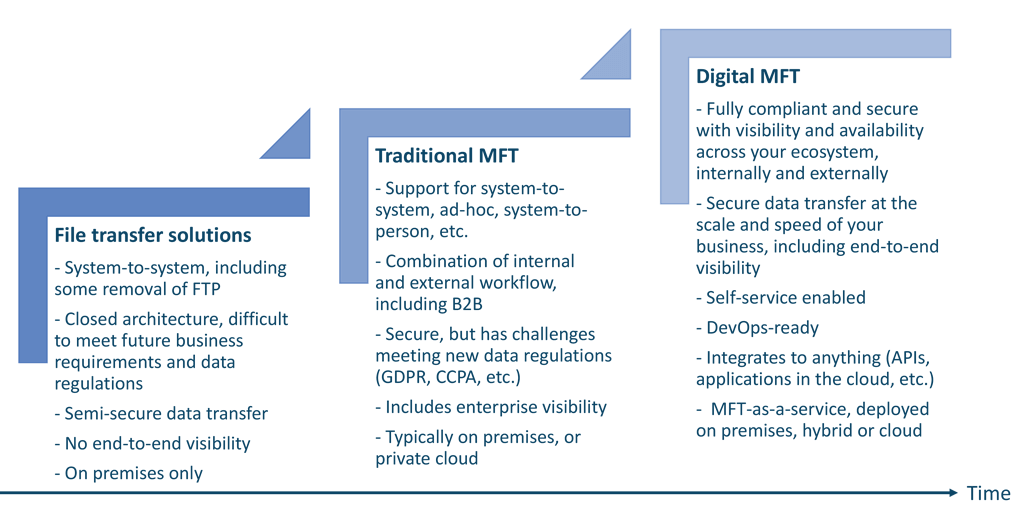The Evolution of Managed File Transfer (MFT)

How will my Managed File Transfer change when we migrate applications to a cloud infrastructure? Do we need Managed File Transfer in the cloud? How do I respond to cloud architects who are looking for cloud native connectivity? My business partners are utilizing SaaS solutions. How do I prepare for the future?
My hope with this post is to provide insights into how Managed File Transfer has evolved in the last decade and where it is headed, to help you make decisions on the kind of MFT service you want to provide for your organization and business partners. We’ll look at the evolution of MFT from both a functionality and an infrastructure standpoint.
Evolving Functionality of MFT
I’ll spare you the full MFT history lesson, and just say that the concept of MFT came about because companies needed control and governance over data movement, both inside and outside the organization. This, of course, is still true today. What’s different is that with the advent of DevOps, cloud infrastructure, and APIs, data movement models have evolved, which means MFT solutions – the way they function, and the way they interact with other applications – have evolved too.
What used to be the mainframe’s job, moving a file from one location to another as a scheduled task, is now expected immediately, as soon as the data is available. File transfer solutions designed to be event driven solved this problem. However, they were limited in functionality and only moved data from one point to another with standard FTP, SFTP and HTTP interfaces, with little emphasis on security.
As traditional Managed File Transfer solutions evolved they added ad-hoc functionality, intelligent routing and data security. These solutions were rigid and had little flexibility, which required costly customizations to make them work. Based on the application, organizations were still limited in functionality and had to rely on multiple MFT applications, resulting in silos and increased cost of ownership.

Enter the Cloud
With the advent of cloud infrastructure and cloud native applications, data flows have changed significantly and businesses need a lot more flexibility and connectivity options to fulfill customer demands. Also expected by today’s standards are capabilities like data streaming, connecting to cloud-native apps, and transferring and storing files in the cloud, all while having the capability to move terabytes of data within a day. Businesses also have to now support both the legacy model and the cloud model of file transfers as organizations migrate applications to cloud infrastructure.
Today, with all of these requirements, a Hybrid Integration Platform (HIP) that provides a digital MFT solution with abundant functionality, flexibility in configuring data flows, and out-of-the-box cloud connectors, along with a scalable and highly available architecture is the way to go. Connectors reduce time-to-market, and enable you to provide better service while reducing development costs. It’s important to note that when choosing a Hybrid Integration Platform, you need to avoid “pitfalls of the past,” where you ended up with solutions in silos, and instead choose an MFT solution that provides all of these capabilities in one application. The application should also be cloud-ready so that it is future-proof.
Digital MFT solutions also provide self-service capabilities so lines-of-business handle their own transfers, while IT maintains control. Faster partner onboarding is another benefit of an evolved, modern file transfer solution.
Changes to Infrastructure
Initially MFT was a boxed solution, installed on servers or provided as part of an appliance, and functionality was limited, as noted above. A few vendors also provided P2P solutions with proprietary protocols that forced organizations to be stuck with those solutions long term. Then came virtual machines, which made MFT a little more flexible and highly available, but still nothing compared to the flexibility you’ll find today. Public cloud infrastructure like Amazon Web Services, Google Cloud Platform, Microsoft Azure and others made it extremely easy to provision servers and applications. I encourage you to consider digital MFT solutions that are cloud ready and can scale in a cloud infrastructure.
Additionally, if you are planning or are in the midst of re-platforming and modernization initiatives, I recommend that you consider a digital MFT solution. The challenge is to provide business continuity while migrating users to the new platform, so be sure to include this in your list of requirements.
Hopefully this look at the evolution of MFT was helpful. I have spoken to many MFT administrators, developers and operations teams facing these challenges.
If you would like help with the questions at the beginning of this post, anything I have recommended here, or would like to know more about an HIP approach, our experts can help.
You want further information concerning this topic? Watch our Webcast On Demand “Be Ready for Tomorrow with a Hybrid Integration Platform Approach”.
SEEBURGER accelerates the business of over 10,000 customers. Our central, agile, scalable integration platform, the SEEBURGER Business Integration Suite (BIS), connects systems, applications, customers and partners. This ensures that the right data reaches the right place at the right time in the right format – within and between companies. The Business Integration Suite is “made by SEEBURGER” and “made in Germany”. It includes B2B, EDI, MFT, EAI and API integration functions that are available in any cloud, hybrid or on-premises.
Thank you for your message
We appreciate your interest in SEEBURGER
Get in contact with us:
Please enter details about your project in the message section so we can direct your inquiry to the right consultant.
Written by: Rakesh Kukkamalla
Rakesh Kukkamalla, Enterprise Architect & VP Solution Engineering is responsible for leading design, development, and delivery of complex, high-performance, scalable integration solutions for SEEBURGER. Since joining SEEBURGER, he has been instrumental in the migration and consolidation of legacy integration solutions to hybrid integration platforms for several organizations in the financial services and insurance industries. His focus today is to help financial organizations in their payments modernization efforts with the adoption of ISO 20022. Rakesh’s expertise in MFT, B2B, APIs, and SEEBURGER’s Payments Integration Hub solutions is key to his work with customers across the globe. He has a bachelor’s degree in computer science from the National Institute of Technology and a master’s degree in computing studies from Arizona State University.





